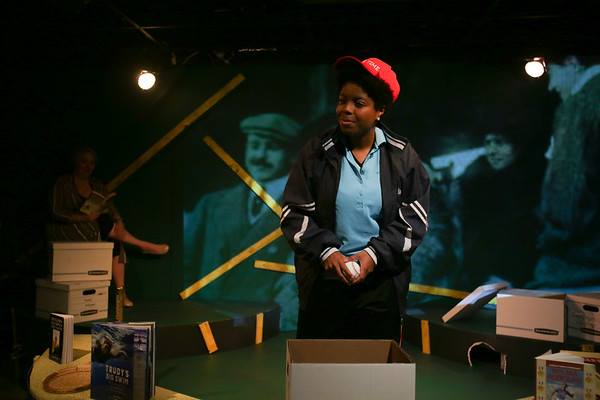Cynthia Cooper’s Running on Glass, playing at Laurel’s Venus Theatre, celebrates six pioneering female athletes, all of whom had to overcome barriers not only of gender but of race, class, illness, or religion to become the champions that they were. The two-women cast gives a deeply personal look at what drove the six to succeed.

Actor/director Deborah Randall and Christine “Tina” Canady begin the play with a framing device: the two are exploring a disused club space in a decrepit mall as a site of a pop-up women’s sports museum. Anna (Canady) is a young, enthusiastic researcher who collects boxes of articles and memorabilia about women sports figures. Ellie (Randall), an older designer, is initially skeptical. As they pull items from the boxes, each athlete, one after the other, tells her story via a monologue. The stories are compelling and well told.
Storytelling is, indeed, the mode of Cooper’s script, which does not have a plot in the conventional sense. In background materials for the show, Randall comments that “the idea we are rooted in linear storytelling is simply not true” for women’s life experiences.
Canady begins by portraying tennis great Althea Gibson, who overcame racial exclusion to become a world-class player. Canady shows her as a hard-nosed street kid fighting her way up the then-segregated tennis ladder, leading to her 1957 triumph in ladies’ singles at Wimbledon over her doubles partner, Darlene Hard.
Next for Canady is Wilma Rudolph, a small-town southern girl who worked hard to overcome the effects of a childhood bout with polio to become a triple gold-medal winner at the 1960 Olympics. A nice feature of this performance is her demonstration of the nuances of the sprinter’s starting technique.
Canady’s final character is Mamie “Peanut” Johnson, who lived most of her life in the DC area. Johnson was a successful (33-8) pitcher with the Indianapolis Clowns in the early-mid 1950s, the waning years of the Negro Leagues (where “only the ball was white,” as in the title of Robert Peterson’s history of the Leagues). Her stint with the Clowns was preceded by a rejection from a women’s professional baseball league tryout because, a year after Jackie Robinson broke the color barrier in the major leagues, the women’s league remained all white. In a ceremonial draft of surviving Negro League players held in 2008 by MLB, Johnson was selected as the Nats’ representative.
Canady brings to life the quite similar determination of her three characters to overcome the barriers they faced and succeed because they wanted to run, or excel at tennis, or play ball, and they were not about to let anyone or anything get in their way.

Randall plays a more varied lot of characters, each distinguished by her own voice, accent, and physicality. Gertrude Ederle – who Randall once met and interviewed – was the first woman to swim the English Channel. Babe Didrikson, from a small-town Texas background, was a multi-sports prodigy who came to notice by winning a track meet all by herself. A highly successful professional golfer, among her many accomplishments was winning her last tournament while fighting what turned out to be terminal cancer. One aspect of her career not mentioned in the play is that she served as an inspiration for the Katherine Hepburn character in Pat and Mike, a film in which she also appeared.
Randall’s final character, and the one that is most likely to be the least familiar to American audiences, is Gretel Bergmann, a German high jumper who was kicked off the 1936 German Olympic team because she was a Jew. Being an athlete who is not allowed to compete was hard but, she comments, at least she didn’t – as did the rest of the German team – have to salute Hitler as part of the Olympic ceremonies.
The play alludes to an equally fascinating woman who does not appear as a character, Eleanor Sears, an early 20th-century Boston patrician (her family hobnobbed with the Roosevelts and Lodges) who, like Didrikson, was a star in numerous sports, especially tennis, squash, and equestrian events. Sears encouraged later women to excel, and she delighted in breaking gender norms, once being arrested for smoking in a posh Boston hotel, a privilege reserved for men at the time.
In Venus Theatre’s small storefront black box theater, the audience inevitably gets to be up close and personal with the characters, an intimacy that demands and receives reality from the actors. In this setting, presentational or declamatory acting would be deadly, and Randall and Canady avoid such sins.
The premier technical feature of the show is a projection of photos depicting each athlete preceding her monologue, accompanied by an appropriate piece of music (e.g., “Let Me Call You Sweetheart” for Didrikson). The longest of these projections comes at the end of the show, a moving coda depicting present-day heirs of these pioneers, such as Serena Williams and Katie Ledecky.
The six athletes were all passionate about their sports, and Randall’s approach to the show is equally passionate, determined, as she says, to avoid the “erasure” of their legacy and to celebrate their power and glory. It’s a celebration well worth attending.
Running Time: 70 minutes, with no intermission.
Running On Glass plays through December 9, 2018, at the Venus Theatre – 21 C Street in Laurel, MD. For tickets, call the box office at (202) 236-4078 or purchase them online.




